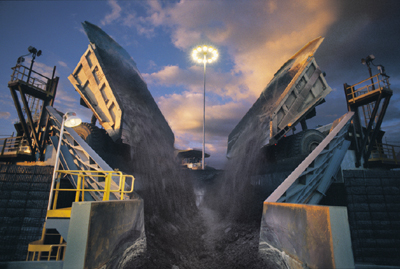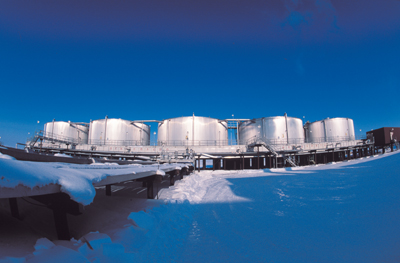
Geotimes Home | AGI Home | Information Services | Geoscience Education | Public Policy | Programs | Publications | Careers

| Libya
opens up
Libya’s decision to give up its programs to develop weapons of mass
destruction make it an area of interest for foreign investment and a major
competitor for Iraq’s oil industry, says Gal Luft, co-director of
the Institute for the Analysis of Global Security in Washington, D.C.
Foreign companies are rushing to get into the country because “Libya
has better oil that is easier to produce,” in addition to being much
more politically stable and safe, Luft says. |
 Surprisingly
enough, Canada is second only to Saudi Arabia in total proven crude oil reserves,
according to the Oil & Gas Journal, at 178.9 billion barrels. But the
majority of these are not typical deposits: They are mostly in shallow, tarry
sand reservoirs. Removing the resource and preparing it for refining is technologically
difficult. Nevertheless, Canada’s “oil sands” have contributed
to a recent boom in the country’s oil production and promise more for the
future.
Surprisingly
enough, Canada is second only to Saudi Arabia in total proven crude oil reserves,
according to the Oil & Gas Journal, at 178.9 billion barrels. But the
majority of these are not typical deposits: They are mostly in shallow, tarry
sand reservoirs. Removing the resource and preparing it for refining is technologically
difficult. Nevertheless, Canada’s “oil sands” have contributed
to a recent boom in the country’s oil production and promise more for the
future. |
Outside of Canada’s immense oil sands, which make up the majority
of its exports at a million barrels of oil a day, the only other oil sands
in production are in Venezuela, says Bob Esser of Cambridge Energy Research
Associates. Vene-zuela exports about 2.5 million barrels a day of crude
oil, according to the U.S. Energy Information Administration (EIA). One-quarter
of that total comes from its oil sands concentrated in the Orinoco Belt,
which produce about 500,000 barrels of crude a day. Naomi Lubick |
 In a
country where oil reserves are a state secret and average winter temperatures
regularly fall well below freezing, foreign investors are cautiously awaiting
reentry to production, exploration and related activities. Despite the ominous
crackdown on Russia’s oil and other business magnates, its oil fields remain
a beacon for international oil companies.
In a
country where oil reserves are a state secret and average winter temperatures
regularly fall well below freezing, foreign investors are cautiously awaiting
reentry to production, exploration and related activities. Despite the ominous
crackdown on Russia’s oil and other business magnates, its oil fields remain
a beacon for international oil companies.  |
Geotimes Home | AGI Home | Information Services | Geoscience Education | Public Policy | Programs | Publications | Careers |